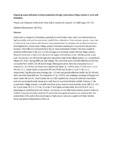Please use this identifier to cite or link to this item:
https://cris.library.msu.ac.zw//handle/11408/1725Full metadata record
| DC Field | Value | Language |
|---|---|---|
| dc.contributor.author | Munodawafa, Adelaide | - |
| dc.contributor.author | Zhou, Neil | - |
| dc.date.accessioned | 2016-07-26T09:01:57Z | - |
| dc.date.available | 2016-07-26T09:01:57Z | - |
| dc.date.issued | 2008 | - |
| dc.identifier.issn | 1474-7065 | - |
| dc.identifier.uri | http://www.sciencedirect.com/science/article/pii/S1474706508001514 | - |
| dc.identifier.uri | http://hdl.handle.net/11408/1725 | - |
| dc.description | Abstract | en_US |
| dc.description.abstract | Soil erosion is rampant in Zimbabwe, especially in small-holder areas, which are characterized by highly erodible soils and low and erratic rainfall. Over utilization of land and poor ground cover, due to removal of crop residues after harvest, have perpetuated the problem and resulted in extensive land degradation. Conservation tillage systems have been developed to try and curb this problem; however, their effect on soil productivity has not been extensively studied. This study sought to quantify rainfall input in the soil, run-off, drainage and soil losses under different tillage systems. Research work was carried out in the semi-arid region of Zimbabwe under infertile granitic sandy soils. Soil erosion, run-off and drainage were quantified under three tillage systems, i.e. conventional tillage (CT), mulch ripping (MR) and tied ridging (TR), over three years. Growth-effective rainfall was computed from rainfall, run-off and drainage. Maize grain yields were also assessed across all treatments. Run-off and soil losses were significantly higher (p < 0.001) under CT (104 mm y−1 and 34 t ha−1 y−1, respectively) compared to MR and TR (40 and 34 mm y−1 and 2 t ha−1 y−1, respectively). Significantly more drainage (by ∼12 mm) and growth-effective rainfall (by 52–58 mm) were recorded under MR and TR compared to CT (p < 0.001), also implying a recharge of the ground-water under MR and TR. Overall yields did not differ significantly among the different treatments and only varied significantly during years with low and poorly distributed rainfall, in favour of the conservation tillage systems. Low yield variations across seasons were recorded under MR (2.2–3.9 t ha−1) and under TR (1.1–3.7 t ha−1), while CT had highly variable yields, from 0.9 to 4.6 t ha−1, depending on rainfall amount and pattern. Soil erosion can be effectively reduced, growth-effective rainfall increased and yields sustained if sustainable management systems are implemented. The productivity of the soils is thus maintained as high erosion rates are coupled with high nutrient losses and general degradation of the soil. | en_US |
| dc.language.iso | en | en_US |
| dc.publisher | Elsevier | en_US |
| dc.relation.ispartofseries | Physics and Chemistry of the Earth;Vol. 33, Issues 8–13; p. 757–761 | - |
| dc.subject | Drainage; Growth-effective rainfall; Run-off; Soil erosion | en_US |
| dc.title | Improving water utilization in maize production through conservation tillage systems in semi-arid Zimbabwe | en_US |
| dc.type | Article | en_US |
| item.openairetype | Article | - |
| item.cerifentitytype | Publications | - |
| item.openairecristype | http://purl.org/coar/resource_type/c_18cf | - |
| item.fulltext | With Fulltext | - |
| item.grantfulltext | open | - |
| item.languageiso639-1 | en | - |
| Appears in Collections: | Research Papers | |
Files in This Item:
| File | Description | Size | Format | |
|---|---|---|---|---|
| A. Munodawafa.pdf | 326.92 kB | Adobe PDF |  View/Open |
Items in MSUIR are protected by copyright, with all rights reserved, unless otherwise indicated.



